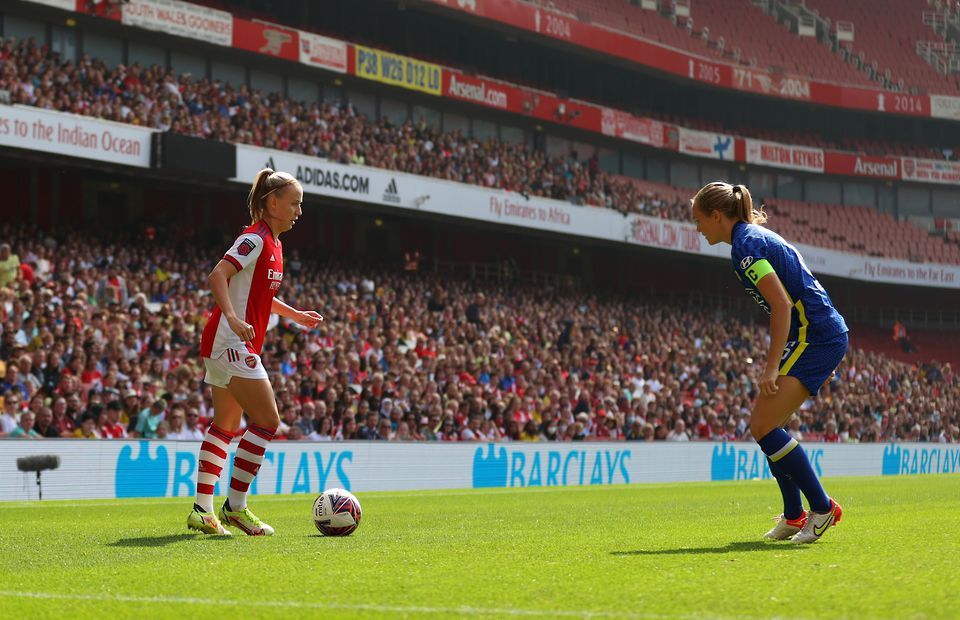After 18 months of lockdown, women’s football fans were suddenly offered a dazzling array of options for watching the new season of the Women’s Super League.
The shiny new WSL broadcast deal meant Manchester United’s opener against Reading and the heavyweight clash between Arsenal and Chelsea was shown on Sky Sports.
Viewers were treated to a dedicated build-up to both games, which included in-depth analysis using high-tech touchscreens.
Everton’s match against Manchester City was also shown on BBC One, attracting a record peak audience of 800,000.
The figure is more than two times higher than the previous record of 305,000, achieved when BT Sport broadcast Arsenal and Manchester City’s meeting last year.
Just short of 25,000 people purchased tickets for the opening weekend of the Women’s Super League, however, choosing the stands of the Emirates, Tottenham Hotspur Stadium or Goodison Park over the tantalising option of watching on Sky Sports or the BBC.
Of this number, 8,705 watched Arsenal narrowly defeat Chelsea 3-2 at the Emirates. Nearly 6,000 were at Goodison as Manchester City thrashed Everton 4-0, while 4,681 fans were in attendance at the Tottenham Hotspur Stadium as Spurs beat Birmingham 1-0.
Brighton welcomed 2,264 spectators to the Amex as they overcame West Ham 2-0, while 2,111 brought tickets to watch Manchester United win 2-0 against Reading at Leigh Sports Village.
The only venue to see spectators dip under the 2,000 mark was at Banks's Stadium, where 741 people saw Aston Villa get past WSL newcomers Leicester City 2-1.
These numbers are impressive, but are relatively low compared to the opening weekend of the 2019-2020 season.
Back then, around 34,000 fans attended the Manchester Derby at the Etihad, while 24,000 were at Stamford Bridge for Chelsea against Tottenham, although many of these tickets were given away for free.
The dip in attendance figures has sparked a debate – should WSL matches be played at main stadia? Does it help grow women’s football in England, or is playing in largely empty stadiums at detriment to the teams?
GiveMeSport Women assesses the advantages and disadvantages.
Could playing at men's stadiums be detrimental to women's football?
Matches at the Emirates, Tottenham Hotspur Stadium and Goodison Park were far from full-capacity at the weekend.
Although the crowd size was large for a women’s football match, the noise of the fans had the potential to get lost in the cavernous surroundings. The atmosphere would have likely been better in a sold-out Meadow Park, Hive Stadium or Walton Hall Park.
As a result, the teams who were supposedly playing at "home" could have lost their advantage, unable to find motivation from the crowd.
There have also been complaints around the facilities on offer at main stadia. Due to the reduced crowd, fewer toilets and food stalls were opened, producing long queues.
This was indeed the case at the Emirates, with many spectators missing kick-off as a result of the significant waiting time to get into the stadium.
Away fans also had reason to gripe, with many forced to sit among the home fans. Chelsea fans complained about the difficulty of finding seats together, urging clubs to organise proper sections for away spectators.
Does women's football benefit from playing at men’s stadiums?
The concerns about the atmosphere at the opening WSL matches turned out to be largely unwarranted. Both Arsenal and Tottenham sold tickets a block at a time, meaning fans were congregated in one area of the stadium instead of scattered across the venue.
This created a wall of sound, which took some time to build at the Tottenham Hotspur Stadium, but was there from kick-off at the Emirates.
Helped by the good weather, home spectators were jubilant as Arsenal played out a nervy conclusion to the game to beat defending champions Chelsea.
Women's matches at men’s stadiums are about more than just atmosphere, however. They help grow the one club mentality, melding the identities of the men and women’s teams together.
Hosting women’s matches at a club’s main stadia makes it impossible for fans of the men’s team to ignore the female players.
This is exactly what Leicester City, Birmingham City and Reading are hoping to achieve by holding the majority of their games at the King Power Stadium, St Andrews and Madejski Stadium respectively.
Games at men’s stadiums are also more accessible. Arsenal fans residing in North London will find it easier to attend a match at the Emirates than at Meadow Park. If they enjoy the fixture, they will be more likely to make the effort to travel out to Borehamwood to watch the women’s team week in, week out.
Finally, playing matches at some of the best football venues in the country gives female players the facilities they deserve, including stunning changing rooms and a world-class pitch.
Clubs undeniably need to improve the experience for women’s football fans at their stadiums, creating dedicated sections for away fans and ensuring there are enough facilities open to prevent long queues.
But it has been proved that a fantastic atmosphere can be created at women’s football games in men’s stadiums, and as more people are exposed to the women’s game through the new broadcast deal, attendance figures will only grow.





















